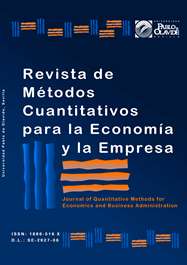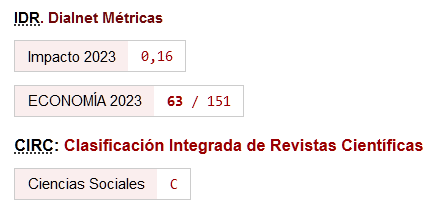El efecto de la satisfacción y el apego a la marca en la fidelidad del consumidor. Aplicación de la técnica PLS-SEM
DOI:
https://doi.org/10.46661/rev.metodoscuant.econ.empresa.6210Palabras clave:
Fidelidad a la marca, preferencia, actitud, satisfacciónResumen
Actualmente, la mejora de la lealtad a la marca es un importante objetivo para las organizaciones. Así, una manera de conseguirlo es mejorar la satisfacción del consumidor y el apego a la marca. Por ello, el objetivo de este estudio es explorar los efectos de la satisfacción del consumidor y el apego emocional a la marca en la fidelidad a la misma. Para este propósito, adoptamos el modelado de ecuaciones estructurales de mínimos cuadrados parciales (PLS-SEM). Los datos fueron reunidos por vía de un cuestionario auto dirigido virtualmente acerca de una muestra compuesta por 210 consumidores de una marca de productos lácteos. Los resultados obtenidos confirman la influencia de la satisfacción y el apego emocional sobre la fidelidad de los consumidores. Este estudio sugiere soluciones marketing facilitando la política de lealtad de los consumidores hacia la marca, sobre todo en la industria láctea.
Descargas
Citas
Aaker, J., & Fournier, S. (1995). A brand as a character, a partner and a person: three perspectives on the question of brand personality. ACR North American Advances, NA-22. https:///www.acrwebsite.org/volumes/7775/volumes/v22/NA-22
Ajzen, I. (1991). The theory of planned behavior. Organizational Behavior and Human Decision Processes, 50(2), 179–211. https://doi.org/10.1016/0749-5978(91)90020-T
Alamro, A., & Rowley, J. (2011). Antecedents of brand preference for mobile telecommunications services. Journal of Product & Brand Management, 20(6), 475–486. https://doi.org/10.1108/10610421111166621
Albert, N. (2014). Le sentiment d’amour pour une marque: Déterminants et pertinence managériale. Management & Avenir, 72(6), 71–89. https://doi.org/10.3917/mav.072.0071
Albert, N., Merunka, D., & Valette-Florence, P. (2010). Développement et validation de deux nouvelles échelles de mesure de l’amour pour une marque. Innovations, n° 31(1), 109–129. https://doi.org/10.3917/inno.031.0109
Andonova, Y., Miller, E. G., & Diamond, W. D. (2015). The Relationships among Self-Brand Congruence, Brand Attachment, Customer Engagement, and Brand Loyalty. Ideas in Marketing: Finding the New and Polishing the Old, 816–816. https://doi.org/10.1007/978-3-319-10951-0_295
Aurier, P., Bernavent, C., & N’goala, G. (2001). Validité discriminante et prédictive des composantes de la relation à la marque. Cahiers de Recherche Du CREGO, 8, 51–70.
Bairrada, C. M., Coelho, F., & Coelho, A. (2018). Antecedents and outcomes of brand love: Utilitarian and symbolic brand qualities. European Journal of Marketing. https://doi.org/10.1108/EJM-02-2016-0081
Baldinger, A. L., & Rubinson, J. (1996). Brand loyalty: The link between attitude and behavior. Journal of Advertising Research, 36(6), 22–35.
Batra, R., Ahuvia, A., & Bagozzi, R. P. (2012). Brand love. Journal of Marketing, 76(2), 1–16. https://doi.org/10.1509/jm.09.0339
Benyoussef, H., Hoffmann, J., & Valette-Florence, P. (2005). Les antécédents relationnels de la fidélité: Le cas des utilisateurs de logiciels propriétaires vs utilisateurs de logiciels libres.
Boss, J.-F. (1993). Pourquoi la satisfaction des clients? Revue française du marketing, 144–145, 5–28.
Boubker, O., & Douayri, K. (2020). Dataset on the relationship between consumer satisfaction, brand attitude, brand preference and purchase intentions of dairy product: The case of the Laayoune-Sakia El Hamra region in Morocco. Data in Brief, 32, 106172. https://doi.org/10.1016/j.dib.2020.106172
Bowlby, J. (1969). Attachment and Loss. Vol. 1, Attachment. New York: Basic, 1982. Attachment and Loss, 2.
Boyer, A., & Nefzi, A. (2008). La relation entre la perception de la qualité et la fidélité: Une application aux sites web commerciaux. La Revue des Sciences de Gestion, 234(6), 37. https://doi.org/10.3917/rsg.234.0037
Cardozo, R. N. (1965). An Experimental Study of Customer Effort, Expectation, and Satisfaction. Journal of Marketing Research, 2(3), 244–249. https://doi.org/10.1177/002224376500200303
Carroll, B. A., & Ahuvia, A. C. (2006). Some antecedents and outcomes of brand love. Marketing Letters, 17(2), 79–89. https://doi.org/10.1007/s11002-006-4219-2
Carvajal, S. A., Leguina, A., & Zamorano, P. E. (2013). Factores determinantes en la percepción de la imagen y calidad de servicio y sus efectos en la satisfacción del cliente: Un caso aplicado a la banca chilena. Revista de ciencias sociales, 19(2), 255-267. https://doi.org/10.31876/rcs.v19i2.25621
Chang, H. H., & Liu, Y. M. (2009). The impact of brand equity on brand preference and purchase intentions in the service industries. The Service Industries Journal, 29(12), 1687–1706. https://doi.org/10.1080/02642060902793557
Chaudhuri, A., & Holbrook, M. B. (2001). The Chain of Effects from Brand Trust and Brand Affect to Brand Performance: The Role of Brand Loyalty. Journal of Marketing, 65(2), 81–93. https://doi.org/10.1509/jmkg.65.2.81.18255
Chinomona, R. (2013). The Influence Of Brand Experience On Brand Satisfaction, Trust And Attachment In South Africa. International Business & Economics Research Journal (IBER), 12(10), 1303–1316. https://doi.org/10.19030/iber.v12i10.8138
Copeland, M. T. (1923). Relation of consumers’ buying habits to marketing methods. Harvard Business Review, 1(2), 282–289.
Cronin, J. J., & Taylor, S. A. (1992). Measuring Service Quality: A Reexamination and Extension. Journal of Marketing, 56(3), 55–68. https://doi.org/10.1177/002224299205600304
Cunningham, R. M. (1956). Brand loyalty-what, where, how much. Harvard Business Review, 34(1), 116–128.
Dick, A. S., & Basu, K. (1994). Customer Loyalty: Toward an Integrated Conceptual Framework. Journal of the Academy of Marketing Science, 22(2), 99–113. https://doi.org/10.1177/0092070394222001
Dufer, J., & Moulins, J.-L. (1989). La relation entre la satisfaction du consommateur et sa fidelite a la marque: Un examen critique. Recherche et Applications En Marketing, 4(2), 21–36. https://doi.org/10.1177/076737018900400202
Ebrahim, R., Ghoneim, A., Irani, Z., & Fan, Y. (2016). A brand preference and repurchase intention model: The role of consumer experience. Journal of Marketing Management, 32(13–14), 1230–1259. https://doi.org/10.1080/0267257X.2016.1150322
Espejel, J., Fandos, C., & Flavián, C. (2008). Consumer satisfaction: A key factor of consumer loyalty and buying intention of a PDO food product. British Food Journal, 110(9), 865–881. https://doi.org/10.1108/00070700810900585
Ferreira, P., Rodrigues, P., & Rodrigues, P. (2019). Brand Love as Mediator of the Brand Experience-Satisfaction-Loyalty Relationship in a Retail Fashion Brand. Management & Marketing-Challenges for the Knowledge Society, 14(3), 278–291. https://doi.org/10.2478/mmcks-2019-0020
Fishbein, M., & Ajzen, I. (1980). Understanding attitudes and predicting social behavior. Englewood Cliffs, NJ, Prentice Hall,.
Frisou, J. (2010). Fidélité et vérité: Une question philosophique aux enjeux théoriques et managériaux. Management Avenir, n° 31(1), 287–303.
Gálveza, J. C. P., López-Guzmánb, T., Gómez-Caseroc, G., & Medina-Viruel, M. J. (2021). Satisfaction and loyalty in musical festivals. Study based on the level of jazz musical knowledge. Cuadernos de Gestion, 21(1), 115–124. Scopus. https://doi.org/10.5295/CDG.180901MM
Ganesh, J., Arnold, M. J., & Reynolds, K. E. (2000). Understanding the Customer Base of Service Providers: An Examination of the Differences between Switchers and Stayers. Journal of Marketing, 64(3), 65–87. https://doi.org/10.1509/jmkg.64.3.65.18028
Govind, R., Singh, J. J., Garg, N., & D’Silva, S. (2019). Not Walking the Walk: How Dual Attitudes Influence Behavioral Outcomes in Ethical Consumption. Journal of Business Ethics, 155(4), 1195–1214. https://doi.org/10.1007/s10551-017-3545-z
Hair, J. F., Risher, J. J., Sarstedt, M., & Ringle, C. M. (2019). When to use and how to report the results of PLS-SEM. European Business Review, 31(1), 2–24. https://doi.org/10.1108/EBR-11-2018-0203
Heilbrunn, B. (2017). Chapitre II. Qu’est-ce qu’une marque ? (Presses Universitaires de France).
Hellier, P. K., Geursen, G. M., Carr, R. A., & Rickard, J. A. (2003). Customer repurchase intention: A general structural equation model. European Journal of Marketing, 37(11/12), 1762–1800. https://doi.org/10.1108/03090560310495456
Hennig-Thurau, T., & Hansen, U. (2013). Relationship Marketing: Gaining Competitive Advantage Through Customer Satisfaction and Customer Retention. Springer Science & Business Media.
Josion-Portail, M., & Julienne, É. (2013). Chapitre 9. Les relations entre les consommateurs et les marques. In Management transversal de la marque (pp. 155-172). Dunod. https://doi.org/10.3917/dunod.miche.2013.01.0155
Kim, J., Morris, J. D., & Swait, J. (2008). Antecedents of True Brand Loyalty. Journal of Advertising, 37(2), 99–117. https://doi.org/10.2753/JOA0091-3367370208
Kleine, S. S., & Baker, S. M. (2004). An integrative review of material possession attachment. Academy of Marketing Science Review, 1(1), 1–39.
Kotler, P. (2000). Marketing Management. The Millennium Edition, Prentice Hall International, Englewood Cliffs, NJ.
Krupicka, A. (2003). Impact de l’ordre d’entrée des marques sur le comportement d’achat des consommateurs: Prise en compte des attitudes, du jugement de typicalité et des préférences. 1141–1161. http://pascal-francis.inist.fr/vibad/index.php?action=getRecordDetail&idt=16252563
Lacoeuilhe, J. (2000). L'attachement à la marque: Proposition d'une échelle de mesure. Recherche et Applications En Marketing (French Edition), 15(4), 61-77.
https://doi.org/10.1177/076737010001500404
Louis, D., & Lombart, C. (2010). Impact de la personnalité de la marque sur la satisfaction et la fidélité du consommateur. Management Avenir, n° 31(1), 31–49. https://doi.org/10.3917/mav.031.0031
Molinillo, S., Japutra, A., Nguyen, B., & Chen, C.-H. S. (2017). Responsible brands vs active brands? An examination of brand personality on brand awareness, brand trust, and brand loyalty. Marketing Intelligence & Planning, 35(2), 166–179. https://doi.org/10.1108/MIP-04-2016-0064
Morgan, R. M., & Hunt, S. D. (1994). The Commitment-Trust Theory of Relationship Marketing. Journal of Marketing, 58(3), 20–38. https://doi.org/10.1177/002224299405800302
Moulins, J.-L., Roux, E., & Diallo, M. F. (2014). De l’image de marque à la fidélité: Un modèle tridimensionnel des relations des consommateurs aux marques. Actes Du Congrès International de l’AFM.
Oliver, R. L. (1980). A Cognitive Model of the Antecedents and Consequences of Satisfaction Decisions. Journal of Marketing Research, 17(4), 460–469. https://doi.org/10.1177/002224378001700405
Oliver, R. L. (1981). Measurement and evaluation of satisfaction processes in retail settings. Journal of Retailing, 57(3), 25–48.
Oliver, R. L. (1997). Satisfaction: A Behavioral Perspective on the Consumer. New York: The McGrawHill Companies. Inc.
Oliver, R. L. (1999). Whence Consumer Loyalty? Journal of Marketing, 63(4_suppl1), 33–44. https://doi.org/10.1177/00222429990634s105
Ouajdouni, A., Chafik, K., & Boubker, O. (2021). Measuring e-learning systems success: Data from students of Higher Education Institutions in Morocco. Data in Brief, 106807. https://doi.org/10.1016/j.dib.2021.106807
Palmatier, R. W., Dant, R. P., Grewal, D., & Evans, K. R. (2006). Factors Influencing the Effectiveness of Relationship Marketing: A Meta-Analysis. Journal of Marketing, 70(4), 136–153. https://doi.org/10.1509/jmkg.70.4.136
Payne, A., & Frow, P. (2017). Relationship marketing: Looking backwards towards the future. Journal of Services Marketing, 31(1), 11–15. https://doi.org/10.1108/JSM-11-2016-0380
Ramírez-Asís, E. H., Palma, M. E. M., & Huerta-Soto, R. M. (2020). Actitud, satisfacción y lealtad de los clientes en las Cajas Municipales del Perú. Retos, 10(20), 329–343. https://doi.org/10.17163/ret.n20.2020.08
Roy, S. K., Eshghi, A., & Sarkar, A. (2013). Antecedents and consequences of brand love. Journal of Brand Management, 20(4), 325–332. https://doi.org/10.1057/bm.2012.24
Sajtos, L., Cao, J. T., Espinosa, J. A., Phau, I., Rossi, P., Sung, B., & Voyer, B. (2020). Brand love: Corroborating evidence across four continents. Journal of Business Research. Scopus. https://doi.org/10.1016/j.jbusres.2020.02.040
Shimp, T. A., & Madden, T. J. (1988). Consumer-object relations: A conceptual framework based analogously on Sternberg’s triangular theory of love. Advances in Consumer Research, 15(1), 163–168.
Sirgy, M. J., Grewal, D., Mangleburg, T. F., Park, J., Chon, K.-S., Claiborne, C. B., Johar, J. S., & Berkman, H. (1997). Assessing the predictive validity of two methods of measuring self-image congruence. Journal of the Academy of Marketing Science, 25(3), 229–241. https://doi.org/10.1177/0092070397253004
Smaoui, F. (2008). Les déterminants de l’attachement émotionnel à la marque: Effet des variables relationnelles et des variables relatives au produit. Proceedings of the 2008 Marketing Trends Congress, 17–19.
Spears, N., & Singh, S. N. (2004). Measuring Attitude toward the Brand and Purchase Intentions. Journal of Current Issues & Research in Advertising, 26(2), 53–66. https://doi.org/10.1080/10641734.2004.10505164
Stauss, B., & Neuhaus, P. (1997). The qualitative satisfaction model. International Journal of Service Industry Management, 8(3), 236–249. https://doi.org/10.1108/09564239710185424
Szymanski, D. M., & Henard, D. H. (2001). Customer satisfaction: A meta-analysis of the empirical evidence. Journal of the Academy of Marketing Science, 29(1), 16–35. https://doi.org/10.1177/0092070301291002
Taylor, S. A., Donovan, L. A. N., & Ishida, C. (2014). Consumer Trust and Satisfaction in the Formation of Consumer Loyalty Intentions in Transactional Exchange: The Case of a Mass Discount Retailer. Journal of Relationship Marketing, 13(2), 125–154. https://doi.org/10.1080/15332667.2014.910076
Theng So, J., Grant Parsons, A., & Yap, S. (2013). Corporate branding, emotional attachment and brand loyalty: The case of luxury fashion branding. Journal of Fashion Marketing and Management: An International Journal, 17(4), 403–423. https://doi.org/10.1108/JFMM-03-2013-0032
Thomson, M., MacInnis, D. J., & Park, C. W. (2005). The Ties That Bind: Measuring the Strength of Consumers’ Emotional Attachments to Brands. Journal of Consumer Psychology, 15(1), 77–91. https://doi.org/10.1207/s15327663jcp1501_10
Torres‐Moraga, E., Vásquez‐Parraga, A. Z., & Zamora‐González, J. (2008). Customer satisfaction and loyalty: Start with the product, culminate with the brand. Journal of Consumer Marketing, 25(5), 302–313. https://doi.org/10.1108/07363760810890534
Vicencio-Ríos, G., Araya-Castillo, L., Millán-Toledo, C., & Flores, Y. R. (2020). Desarrollo de la investigación en personalidad de marca. Rev. Venez. de Gerenc, 25, 1583–1599.
Westbrook, R. A., & Oliver, R. L. (1981). Developing Better Measures of Consumer Satisfaction: Some Preliminary Results. Advances in Consumer Research, 8(1), 94–99.
Woodruff, R. B., Cadotte, E. R., & Jenkins, R. L. (1983). Modeling Consumer Satisfaction Processes Using Experience-Based Norms. Journal of Marketing Research, 20(3), 296–304. https://doi.org/10.1177/002224378302000308
Zeithaml, V. A., Berry, L. L., & Parasuraman, A. (1996). The Behavioral Consequences of Service Quality. Journal of Marketing, 60(2), 31–46. https://doi.org/10.1177/002224299606000203
Publicado
Cómo citar
Número
Sección
Licencia
Derechos de autor 2023 Omar Boubker, Abdellah Aatar

Esta obra está bajo una licencia internacional Creative Commons Atribución-CompartirIgual 4.0.
El envío de un manuscrito a la Revista supone que el trabajo no ha sido publicado anteriormente (excepto en la forma de un abstract o como parte de una tesis), que no está bajo consideración para su publicación en ninguna otra revista o editorial y que, en caso de aceptación, los autores están conforme con la transferencia automática del copyright a la Revista para su publicación y difusión. Los autores retendrán los derechos de autor para usar y compartir su artículo con un uso personal, institucional o con fines docentes; igualmente retiene los derechos de patente, de marca registrada (en caso de que sean aplicables) o derechos morales de autor (incluyendo los datos de investigación).
Los artículos publicados en la Revista están sujetos a la licencia Creative Commons CC-BY-SA de tipo Reconocimiento-CompartirIgual. Se permite el uso comercial de la obra, reconociendo su autoría, y de las posibles obras derivadas, la distribución de las cuales se debe hacer con una licencia igual a la que regula la obra original.
Hasta el volumen 21 se ha estado empleando la versión de licencia CC-BY-SA 3.0 ES y se ha comenzado a usar la versión CC-BY-SA 4.0 desde el volumen 22.










